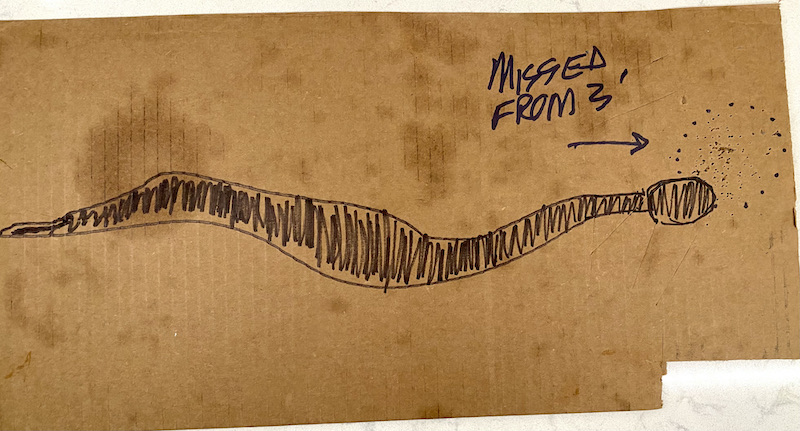
Author Archives: Steve Mays
Honeywagon
 A nice young man showed up this morning to pump out the contents of our septic tank. Watching him work, I was reminded of the slang term, “honey wagon.” Let’s go to Wikipedia:
A nice young man showed up this morning to pump out the contents of our septic tank. Watching him work, I was reminded of the slang term, “honey wagon.” Let’s go to Wikipedia:
A honeywagon is the slang term for a “vacuum truck” for collecting and carrying human excreta. These vehicles may be used to empty the sewage tanks of buildings, aircraft lavatories, passenger train toilets and at campgrounds and marinas as well as portable toilets. The folk etymology behind the name ‘honeywagon’ is thought to relate to the honey-colored liquid that comes out of it when emptying the holding tanks.
They honeywagon has a long history:
The honey wagon was originally a horse-drawn vehicle that went through back alleys to collect human excreta. Houses at that time did not have flush toilets or indeed any form of indoor sanitation beyond the chamberpot. In rural areas the outhouse (privy) is associated with a pit latrine of various sorts, but many towns and cities depended on some variant of the pail closet, which needed frequent emptying. At each outdoor toilet, the driver would stop the wagon, flip up the back hatch door (trap-door) of the outhouse, slide out the pail (bucket), pick it up, and dump the contents into one of eight oak half-barrels in the wagon box. The half-barrels had no lids.
Like the young man told me this morning, “Somebody’s gotta do it.” In the television and film industry, the term has a different meaning.
In America, the term honeywagon is usually given to a truck, trailer or combination of both with a number of dressing rooms for the actor. These either have individual toilets or a communal set built in. Some honeywagons will be just two large toilets. Others are a combination of variously sized rooms for specific purposes: these rooms can be private dressing rooms assigned to a single person, larger rooms configured for the wardrobe, or makeup departments, small individual toilets for the crew to share, and multiple user or individual shower rooms for bathing.
What, you thought Meryl Streep used a Porta Potty?
Septic Tank
When we built our house 40+ years ago, we had to have a well dug and a septic system to dispose of sewage. I had reservations about both but the guy who designed our house assured me we wouldn’t have a problem with either. And he was mostly right. We had to have our well worked on following a lightening strike but our septic system has been trouble-free.
It recently occurred to me we have never had our septic tank emptied. In forty years! That didn’t seem possible but I’m 99% certain. So I contacted a company that inspects and empties septic tanks.

John and Jose showed yesterday and put a few hours of back-breaking work into digging down to our tank (18 inches) in search of the lid to the tank. They never found it (the lid) and had to cut a hole in the tank and install a “riser” with a new lid.
Looking down into the hole they cut in the tank, I could see the tank was nearly full. John explained that we had never had an odor problem because the tank and the drain field was properly installed, using good materials.
Like an aerator (see photo below). Most aerobic septic systems require a septic tank aerator to assist in the clarification of your wastewater. … This bacteria breaks down the wastewater rendering it harmless to the environment. If you have an aerobic system a properly functioning aerator is absolutely necessary. In the photo below you can see our had long ago given up the ghost.

In a few days the company will send a special truck to pump out the septic and — once it arrives — install a new aerator. If all this work sounds expensive, it is. But this is a part of rural living where skimping is a mistake.
Update (12/8/22): Smoke test

Leaving home. Again.
“At the height of the pandemic, more people under 30 were living with their parents than were living on their own. Pew found that 52 percent of young adults ages 18 to 29 were living in their parents’ homes last summer, up from 46 percent at the start of the year. The percentage of young people who returned home was even higher than in 1940, when, at the end of the Great Depression, 48 percent of young adults lived with their parents.”
New York Times
Allen Hammock

Delightful visit with Allen Hammock this morning. Allen and his “cyber twin,” Dan Arnall, guided Learfield’s early internet efforts. L-R: Allen, Mays, Lear.
Wildlife: Snake!
Surrounded by woods, we usually seem some Copperhead snakes every spring and summer. I hate snakes. And when I see ’em, I kill ’em, lest they bite one of our dogs. Not that hard to chop off a head if you happen to have shovel or hoe handy (you never do). By the time you drag the dog inside and find an implement, the snake has escaped.
A couple of years ago I bought a “snake grabber” and keep it next to our deck since that’s where they tend to hang out. You can grab the bastards and lock the grabber while you find something to send them to snake heaven.
It’s an unpleasant experience and a while back I purchased a .22 revolver and loaded it with snake rounds. Instead of a single lead slug, it’s like a tiny shotgun shell filled with little pellets. Can’t miss, right? Well, yeah, you can. Once a year I take the pistol out and fire a round, just to keep in practice.

This was less than three feet away and I managed to miss the snake’s head. So our first line of defense will probably be the grabber and a shovel.
UPDATE June 5, 2021: Riley spotted a Copperhead early last evening. About 2 feet long. Used the snake grabber to hold the thing while I sent it to snake heaven with a shovel.
New sofa
Our new sofa was delivered today. At first glance, you might not see much difference.The old sofa cushions (seat and back) were more like pillows. Stuffed with some kind of feathers, if I had to guess.  The new sofa is more firm. The seats and backs seem to be made of solid foam material.
The new sofa is more firm. The seats and backs seem to be made of solid foam material.
The real test is yet to come.

The Upswing
The Upswing: How America Came Together a Century Ago and How We Can Do It Again
“In a sweeping overview of more than a century of history, drawing on his inimitable combination of statistical analysis and storytelling, Robert Putnam analyzes a remarkable confluence of trends that brought us from an “I” society to a “We” society and then back again.” (Amazon)
I’m only a few chapters into this book and remain skeptical America can ever be a “We” society again. Perhaps the authors can convince me before I’m done. I’ll post a few excerpts without comment because… I wouldn’t know what to say.
“Buoyed by his landslide victory in 1964, LBJ moved to the left on issues of race and inequality, beginning to open an ideological divide that would widen steadily for the next half century. Nevertheless, across LBJ’s far-reaching Great Society initiatives (the War on Poverty, Civil Rights, Voting Rights, Medicare/Medicaid, federal aid to education, and immigration reform—the very issues at the core of intense party polarization in our own period, a half century later), all major bills were supported by majorities or substantial minorities within both parties. On average, these bills were supported by 74 percent of congressional Democrats and 63 percent of congressional Republicans, a fact forgotten by later Republicans who would rail against the leftist extremism of the Great Society programs.”
“This increasing affective polarization has influenced even attitudes to intermarriage. Between 1960 and 2010 opposition to one’s offspring marrying an out-partisan rose from 4 percent to 33 percent among Democrats and from 5 percent to 49 percent among Republicans. This partisan prejudice shows up both in online dating and in actual marriages, as people are increasingly choosing their partners on the basis of political affiliation, even more than on the basis of education or religious orientation. Over the last half century marriage across racial and religious lines has become much more common than either used to be, whereas marriage across party lines has become much less common. This increasing agreement between husband and wife about politics in turn strengthens the inheritance of party identity by the next generation, since we know that children are more likely to inherit party identity when both parents agree politically. In this very intimate way, over the last half century partisanship has gradually replaced religion as the main basis of “tribal” affiliation in America.” (Emphasis mine)
Memorial Day
A Distant Mirror: The Calamitous 14th Century
The Black Death was a bubonic plague pandemic occurring in Afro-Eurasia from 1346 to 1353. It is the most fatal pandemic recorded in human history, causing the death of 75–200 million people in Eurasia and North Africa, peaking in Europe from 1347 to 1351.
Plagues are (were?) something from history books and I never expected to live through one (assuming I live through this one). That, along with the whole “Dark Ages” thing has held a morbid fascination for me, so I looked around for a good book on the Middle Ages and came up with A Distant Mirror: The Calamitous 14th Century. It’s is a narrative history by the American historian Barbara Tuchman, first published in 1978. The main title, A Distant Mirror, conveys Tuchman’s thesis that the death and suffering of the 14th century reflect those of the 20th century, particularly the horrors of World War I.
I’m about halfway through the 600 page book and on almost every page I find some jaw-dropping parallel with the time we’re living through. Just one example: As businesses start opening up there’s lots of complaining they can’t find people willing to work (for minimum wage). The most-cited cause is the payments sent to people to help them through the pandemic. Now, from Tuchman’s book:
When death slowed production, goods became scarce and prices soared. In France the price of wheat increased fourfold by 1350. At the same time the shortage of labor brought the plague’s greatest social disruption— a concerted demand for higher wages. Peasants as well as artisans, craftsmen, clerks, and priests discovered the lever of their own scarcity. Within a year after the plague had passed through northern France, the textile workers of St. Omer near Amiens had gained three successive wage increases. In many guilds artisans struck for higher pay and shorter hours. In an age when social conditions were regarded as fixed, such action was revolutionary.
The response of rulers was instant repression. In the effort to hold wages at pre-plague levels, the English issued an ordinance in 1349 requiring everyone to work for the same pay as in 1347, Penalties were established for refusal to work, for leaving a place of employment to seek higher pay. and for the offer of higher pay by employers. Proclaimed when Parliament was not sitting, the ordinance was reissued in 1351 as the Statute of Laborers. It denounced not only laborers who demanded higher wages but particularly those who chose “rather to beg in idleness than to earn their bread in labor.” Idleness of the worker was a crime against society, for the medieval system rested on his obligation to work. The Statute of Laborers was not simply a reactionary dream but an effort to maintain the system. It provided that every able-bodied person under sixty with no means of subsistence must work for whoever required him. that no aims could be given to able-bodied beggars, that a vagrant serf could be forced to work for anyone who claimed him. Down to the 20th century this statute was to serve as the basis for “conspiracy” laws against labor in the long struggle to prevent unionization.”
Sound familiar? The most striking thing about the Middle Ages is how little has changed. Oh sure, technologies, economies, institutions, etc have evolved but 21st century man is just as venal and corrupt as in the 1300’s. As calamitous as the 14the century was, I find reading about it strangely reassuring. If humanity was able to survive that time, it might survive this one. Even if western democracy does not.





